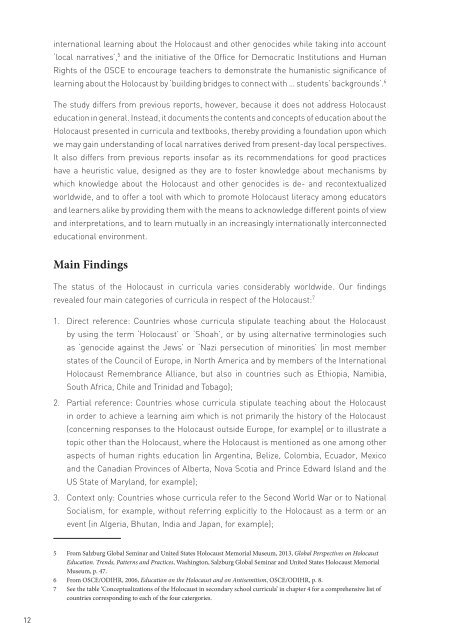228776e
228776e
228776e
Create successful ePaper yourself
Turn your PDF publications into a flip-book with our unique Google optimized e-Paper software.
international learning about the Holocaust and other genocides while taking into account<br />
‘local narratives’, 5 and the initiative of the Office for Democratic Institutions and Human<br />
Rights of the OSCE to encourage teachers to demonstrate the humanistic significance of<br />
learning about the Holocaust by ‘building bridges to connect with … students’ backgrounds’. 6<br />
The study differs from previous reports, however, because it does not address Holocaust<br />
education in general. Instead, it documents the contents and concepts of education about the<br />
Holocaust presented in curricula and textbooks, thereby providing a foundation upon which<br />
we may gain understanding of local narratives derived from present-day local perspectives.<br />
It also differs from previous reports insofar as its recommendations for good practices<br />
have a heuristic value, designed as they are to foster knowledge about mechanisms by<br />
which knowledge about the Holocaust and other genocides is de- and recontextualized<br />
worldwide, and to offer a tool with which to promote Holocaust literacy among educators<br />
and learners alike by providing them with the means to acknowledge different points of view<br />
and interpretations, and to learn mutually in an increasingly internationally interconnected<br />
educational environment.<br />
Main Findings<br />
The status of the Holocaust in curricula varies considerably worldwide. Our findings<br />
revealed four main categories of curricula in respect of the Holocaust: 7<br />
1. Direct reference: Countries whose curricula stipulate teaching about the Holocaust<br />
by using the term ‘Holocaust’ or ‘Shoah’, or by using alternative terminologies such<br />
as ‘genocide against the Jews’ or ‘Nazi persecution of minorities’ (in most member<br />
states of the Council of Europe, in North America and by members of the International<br />
Holocaust Remembrance Alliance, but also in countries such as Ethiopia, Namibia,<br />
South Africa, Chile and Trinidad and Tobago);<br />
2. Partial reference: Countries whose curricula stipulate teaching about the Holocaust<br />
in order to achieve a learning aim which is not primarily the history of the Holocaust<br />
(concerning responses to the Holocaust outside Europe, for example) or to illustrate a<br />
topic other than the Holocaust, where the Holocaust is mentioned as one among other<br />
aspects of human rights education (in Argentina, Belize, Colombia, Ecuador, Mexico<br />
and the Canadian Provinces of Alberta, Nova Scotia and Prince Edward Island and the<br />
US State of Maryland, for example);<br />
3. Context only: Countries whose curricula refer to the Second World War or to National<br />
Socialism, for example, without referring explicitly to the Holocaust as a term or an<br />
event (in Algeria, Bhutan, India and Japan, for example);<br />
5 From Salzburg Global Seminar and United States Holocaust Memorial Museum, 2013, Global Perspectives on Holocaust<br />
Education. Trends, Patterns and Practices, Washington, Salzburg Global Seminar and United States Holocaust Memorial<br />
Museum, p. 47.<br />
6 From OSCE/ODIHR, 2006, Education on the Holocaust and on Antisemitism, OSCE/ODIHR, p. 8.<br />
7 See the table ‘Conceptualizations of the Holocaust in secondary school curricula’ in chapter 4 for a comprehensive list of<br />
countries corresponding to each of the four catergories.<br />
12




